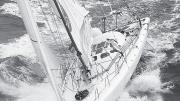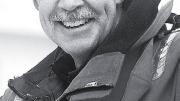Three thousand have climbed Mount Everest; there’ve been about 500 astronauts; but fewer than 50 have ever sailed solo, nonstop, around the world. Rich Wilson ’72, M.B.A. ’82, is one of them. In 121 days spanning late 2008 and early 2009, Wilson competed in what he calls “the world’s greatest sailing race,” the quadrennial Vendée Globe. It begins and ends in Les Sables d’Olonne, a coastal town in the Vendée department of western France. Its route takes the intrepid skippers through the treacherous southern waters around the Cape of Good Hope, south of Australia, and around Cape Horn. Beyond that, you’re free to improvise: the directions aren’t much more specific than the title of Wilson’s 2012 book on his experience, Race France to France, Leave Antarctica to Starboard. Of the 30 who set sail in 2008, he placed ninth among the 11 finishers in the exhausting, nearly unbelievable test of endurance, seamanship, and character. He was the oldest skipper (at 58), the only American, and the only asthmatic—he takes four drugs a day to control symptoms.
Wilson wasn’t racing just for thrills. He’s a former Boston high-school math teacher who puzzled over the question of how to get kids to pay attention and engage with the learning process. His guiding purpose for the race was connecting his circumnavigation to sitesALIVE! (www.sitesalive.com), the nonprofit educational foundation he launched to connect schoolchildren worldwide with adventures and expeditions as they unfold in real time. “Once you’ve hooked the kids with excitement,” he says, “you can feed them whatever content you want—math, science, nutrition, biology, astronomy, teamwork, perseverance, goal-setting.” At the start of the Vendée Globe, he had 25 newspapers under contract to publish his dispatches as the race progressed; they reached seven million readers, plus 250,000 K-12 students in classrooms who could communicate with him, and each other, online. “If you could get a kid in Beijing talking to a kid in Bogotá, who is talking to a kid in Boston,” he says, “now, that would be cool.”
There was much to talk about. Wilson’s 60-foot boat, the Great American III, built in 2000, was two shipbuilding generations older than the competing state-of-the-art vessels. Still, it was loaded with electronics, desalinization equipment, and solar panels, and had 51 control lines running to the cockpit. He was provisioned to eat four meals—6,000 calories—daily to fuel the nearly constant exertion that single-handed sailing demands (even so, he lost four pounds during the race).
Yet nothing could prepare Wilson for the huge storm that hit the racers in the Atlantic, two days out. Fifty knots of wind and high, unruly seas battered the fleet: “There was carnage, chaos, and three skippers suffered broken masts and had to withdraw from the race,” he reports. A huge uppercut wave slammed the Great American III and threw Wilson six feet through the air against a stainless-steel grab bar; the impact jackknifed him and broke two ribs. That was only one of the trials on the 28,790-nautical-mile race; another was ascending 65 feet of the 90-foot mast for a repair (“The single most fearful thing is going aloft”). Sleep deprivation was extraordinary (he averaged only four to five hours of sleep per day), and “there’s an exponential, accumulated fatigue curve for both boat and skipper,” he says. (He once slept through his 120-decibel Sonic Boom alarm clock.)
Yet there were rewards: a Frenchwoman sewed a dress made of U.S. flags to wear for Wilson’s arrival, and at the prize-giving ceremony, the 120,000 sailing fans present heard his speech in fluent French. A taxi driver even asked for his autograph at the Charles de Gaulle Airport—a real surprise, for, as he explains, “when I’m at home in Marblehead, no one knows who I am.”










